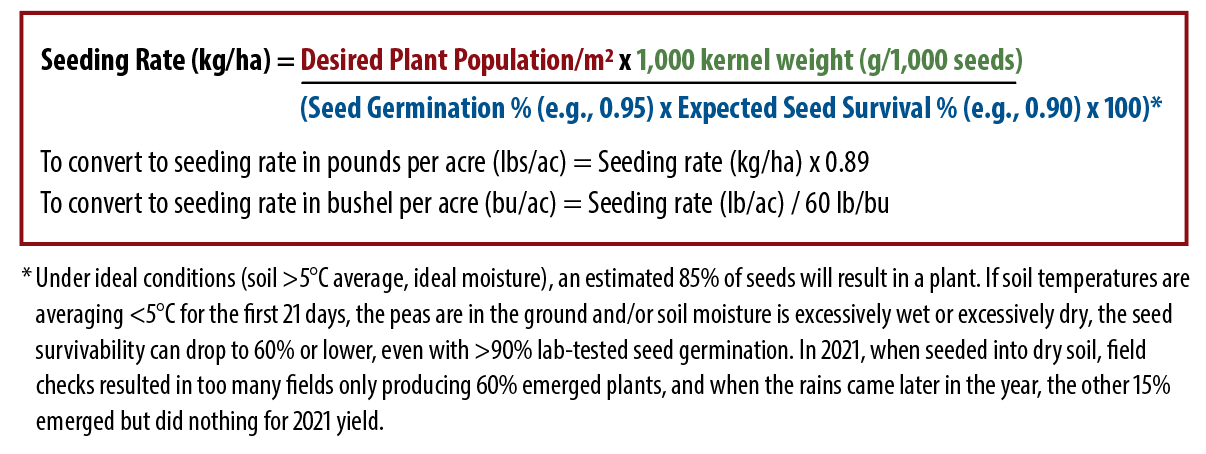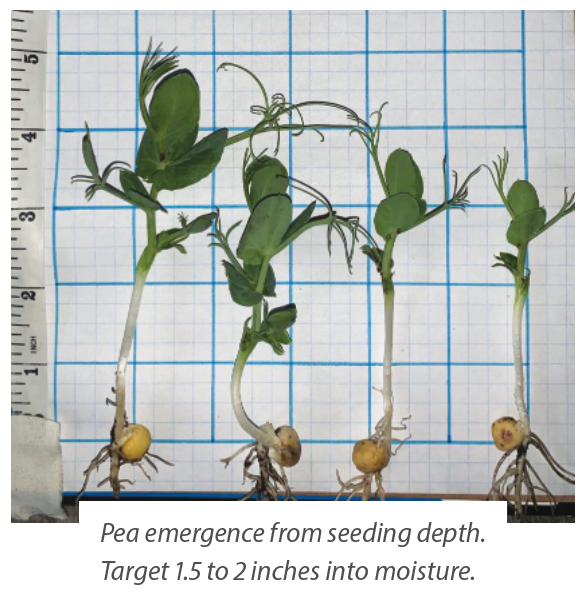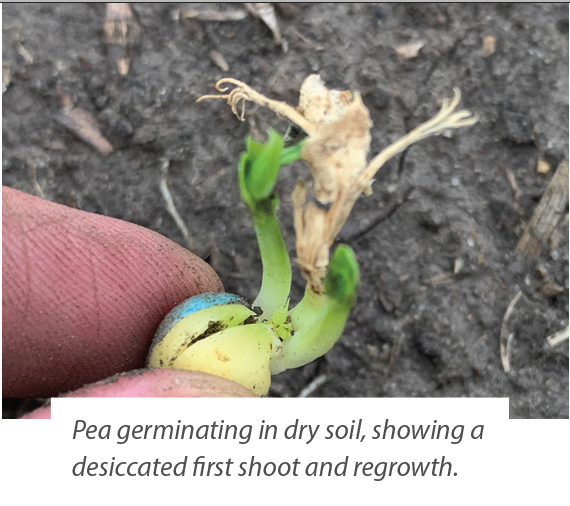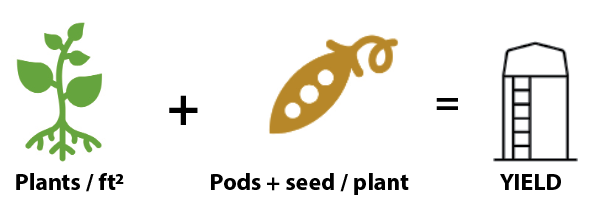Anastasia Kubinec, Agronomist, Roquette Canada Ltd. – Spring 2022 Pulse Beat
WITH FIELD PEAS and other crops, yield potential is a function of the number of plants/acre multiplied by the number of pods/plant, seeds/pod and seed size. Extra plants make for good yield insurance for unexpected curves thrown by Mother Nature. Lower plant populations can achieve high yields, but crop management practices (e.g., seed placement, diligent weed control) need to be excellent as your margin of error is small.
Unfortunately, seeds put in the ground do not mean the same amount of plants will come out of the ground. Soil moisture, seed placement in soil, seed germination, seed size and seed handling damage will impact successful plant emergence. The below recommendations are meant to reduce stress to the seed and increase emerging plants counts. You will have heard most of these before, but a few really showed up as issues in 2021 due to prolonged dry soil conditions from seeding all the way to harvest.
PLANNING FOR SUCCESS
- Seed quality – This is your starting point. If poor quality seed is put in the ground, there isn’t much that can be done to make the seed do any better. Germination % is the key thing to look at. This will indicate how many seeds will make a plant (if everything else is good).
- Use target plant population for seeding rate – General ‘rule of thumb’ seeding rate for peas is 3 bu/ac, but with differences in seed size and % germination, it is better to take a little time and calculate the actual seeding rate needed for a specific targeted stand. The recommended stand to achieve is 7–8 plants/ft2 (75–85 plants/m2). The chart below can give you an idea of seed size and resulting seeding rates or can help you calculate on your own.


- Gentle seed handling – The high-germination seed you cleaned or picked up can be damaged as you are loading it into the seeder or as it is being metered out during seeding operations. Pulse crop seeds, including peas, need gentle treatment. Reducing handling or using a conveyor belt, if possible, will help reduce seed cracks as they go into the tank. If an auger is what you have for loading, slow and full (as you can do based on equipment) is the best option. Once in the tank of the seeder, reducing fan speed in the tank can help reduce the seeds bouncing around and cracking before they go down into the furrow.
- Seeding date – Peas are cold-tolerant, similar to spring wheat and barley. Once peas are in the ground, you want them to emerge as quickly and uniformly as possible. Start seeding when soils at seeding depth (1.5–2 inches) average 5°C for 3–5 days with no <0°C air temperatures in the forecast for next week. At 5°C, plants will emerge in 3+ weeks, at 10°C emergence occurs in 10–14 days. If you can wait for warmer soils, you will reduce stress on the plant as it is emerging, which will increase plant stand success.
- Seeding depth – The range for optimal germination is 1.5 to 2 inches into moisture. The ‘into moisture’ part showed to be critically important in 2021. Pea seeds are big and need moist soils to hydrate the seed, start germination and continue to support the seedling until it breaks the soil’s surface. Successfully emerged plants in 2021 were more likely to have seed attached 2 inches below the soil line, whereas ungerminated seeds in the same row would be found at 1/2 to 1-inch depth.
- Checking seeding depth is important as soil conditions change, but it is also important to make sure you are also checking seeding depth across the width of your seeder to ensure wings or sections are not in too deep or shallow. With good conditions, you will not see the patterns of uneven seed placement, but in stressful conditions, the tell-tale strips of delayed or reduced emergence will appear.

- Checking seeding depth is important as soil conditions change, but it is also important to make sure you are also checking seeding depth across the width of your seeder to ensure wings or sections are not in too deep or shallow. With good conditions, you will not see the patterns of uneven seed placement, but in stressful conditions, the tell-tale strips of delayed or reduced emergence will appear.
- Fertilizer toxicity and placement – Pea stands will be reduced from fertilizer toxicity when the fertilizer concentration is too high, too close to the seed. Even with reduced fertilizer needs of peas compared with wheat, the placement and amount of fertilizer need to be considered when put down at seeding. Manitoba Agriculture has excellent recommendation online that you can access by searching “safe rates of seed-placed P MB.”
- Seed treatment – When there are stressful spring conditions, such as cold and wet soils, seed-borne disease, or planting into soils known to have root rot issues, a seed treatment is an obvious choice. It reduces the impact of soil-borne and seed-borne disease on the seedling during emergence and in the first few weeks of life. In a spring where soils are warm and dry, there is no known seed- or soil-borne disease issues, a seed treatment may not be needed.
- If using a fungicide seed treatment and a liquid or peat on-seed inoculant, the compatibility between the two products needs investigation, as some seed treatments will reduce the viability of the inoculant. If using a granular inoculant, the concerns over compatibility are reduced. Talk to your retailer or seed treatment manufacturer representative for more details.
- Rhizobium inoculant – This is needed under all conditions. It does not increase plant emergence, but once the plant is growing, it is the source of rhizobium inoculant that helps the pea plant make nodules to convert atmospheric nitrogen into a plant-usable source. Liquid or peat on-seed or granular in-furrow are the available forms. As you organize your seed amounts, ensure you are also are ordering the inoculant that you need.
Every crop year is different and will have challenges. Focusing at seeding on achieving good, uniform plant stands in peas will increase season-long success in timing and effectiveness of management. More plants equals more competition versus weeds; uniform plant development equals more crop at the correct stage for application of herbicides and fungicides. ■


